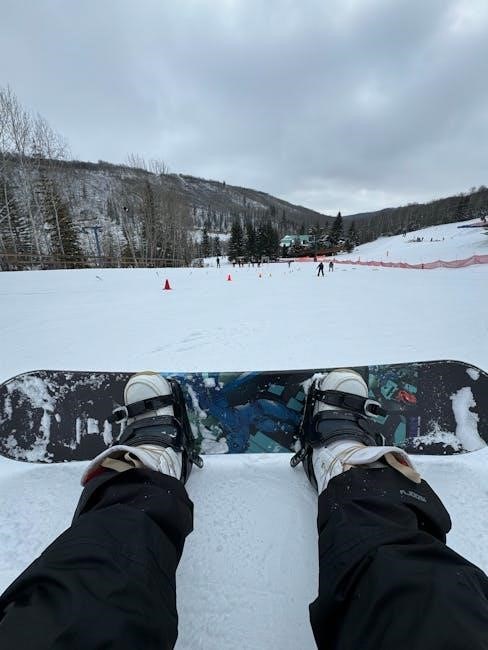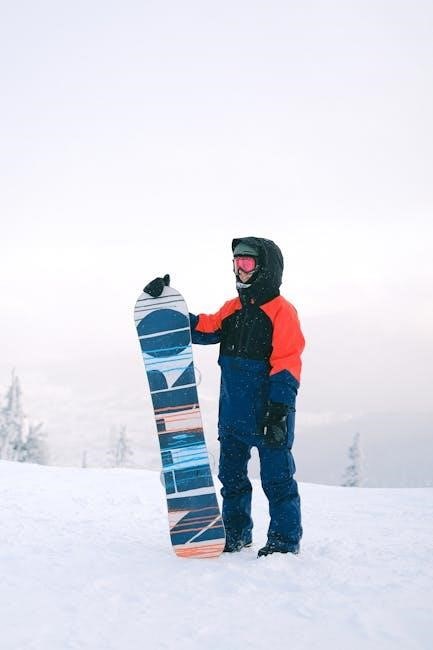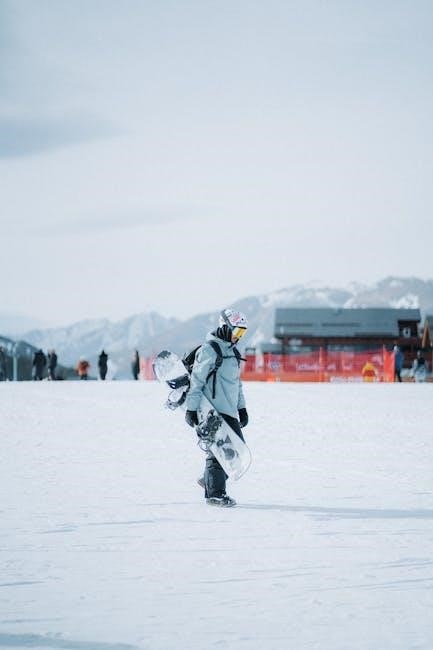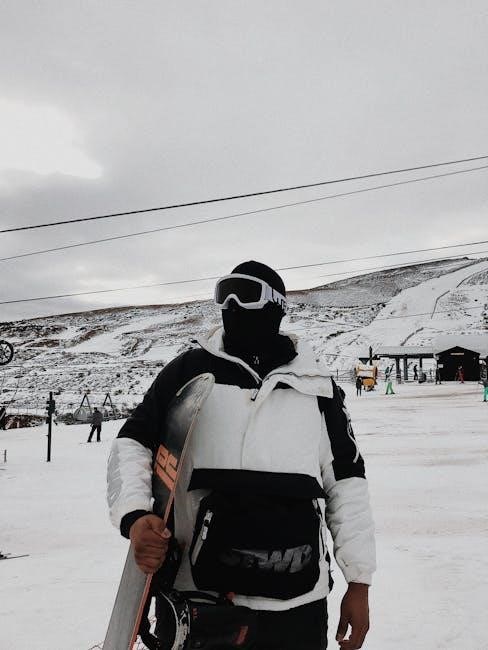Stance width is crucial for snowboarding performance, affecting balance and control. This guide covers measuring, setting up, and customizing your stance for optimal comfort, riding style, and efficiency.

Understanding Stance Width
Stance width refers to the distance between your snowboard bindings, measured center-to-center. Proper width enhances stability, control, and performance, making it a key factor in customizing your ride.
Definition of Stance Width
Stance width in snowboarding is the distance between the centers of the two bindings on the snowboard. It is measured from the center of the front binding to the center of the rear binding. Proper stance width is essential for maintaining balance, stability, and control while riding. A well-adjusted stance width allows for efficient energy transfer, better maneuverability, and improved overall performance. The ideal stance width varies depending on factors such as rider height, weight, boot size, and personal preference. It is typically recommended to start with a stance slightly wider than shoulder width and fine-tune it for comfort and performance. Measuring stance width accurately ensures a customized fit for optimal snowboarding experiences.
Why Stance Width Matters
Stance width plays a critical role in snowboarding by directly impacting balance, control, and overall performance. A proper stance width ensures stability, making it easier to maintain equilibrium on various terrains. It also enhances turning efficiency and responsiveness, allowing for smoother transitions between edges. Additionally, stance width affects the distribution of weight, which influences how the snowboard interacts with the snow. A stance that is too wide or too narrow can lead to fatigue, reduced maneuverability, and increased difficulty in navigating challenging conditions. By optimizing stance width, riders can improve their ability to absorb shocks, initiate turns, and maintain fluid movement, ultimately enhancing their snowboarding experience and skill progression.

Factors Influencing Stance Width
Rider height, weight, boot size, snowboard length, and personal comfort are key factors influencing stance width. Proper alignment ensures optimal performance and efficiency.
Rider Height and Weight
Rider height and weight significantly influence stance width, as they affect balance and control. Taller riders generally benefit from a wider stance for stability, while shorter riders may prefer a narrower setup. Similarly, heavier riders often opt for a slightly wider stance to distribute weight more evenly, enhancing floatation in powder and overall stability. However, these are general guidelines, and personal comfort should always be prioritized. Proper stance width ensures efficient energy transfer and maneuverability, making it easier to adapt to various snow conditions. Ultimately, a stance that aligns with your body proportions and riding style is key to improving performance and enjoyment on the slopes.
Boot Size
Boot size plays a significant role in determining stance width, as larger boots may require a slightly wider stance to prevent toes from dragging in the snow. This ensures proper balance and control while riding. Riders with bigger boots often benefit from a stance that accommodates their footwear comfortably, avoiding discomfort or restricted movement. Conversely, smaller boots may allow for a narrower stance without sacrificing performance. While boot size is an important factor, it should be considered alongside other elements like rider height, weight, and personal preference to achieve the optimal stance width for a seamless snowboarding experience.
Snowboard Length and Width
Snowboard length and width significantly influence stance width, as they affect balance and maneuverability. A longer snowboard typically requires a slightly wider stance for stability, while a shorter board may allow for a narrower stance. The width of the snowboard, particularly at the waist, also plays a role, as it determines how the bindings are positioned. A wider snowboard may accommodate a broader stance, enhancing float in powder, while a narrower board may require a more compact stance for precision. Ultimately, the snowboard’s dimensions should complement the rider’s stance width to ensure optimal performance and control, whether carving, cruising, or navigating challenging terrain.
Personal Comfort and Preference
Personal comfort and preference play a significant role in determining stance width. While general guidelines provide a starting point, the ideal stance is one that feels natural and comfortable for the rider. Some snowboarders prefer a wider stance for stability and balance, while others opt for a narrower stance for easier maneuverability. Factors such as how the rider stands naturally, their flexibility, and their muscle memory also influence stance width. It’s essential to experiment and adjust the stance to suit individual comfort, as this directly impacts performance and enjoyment on the snow. A stance that feels right ensures better control, confidence, and overall riding experience.
Measuring Stance Width
Measuring stance width involves determining the distance between your feet when standing on the snowboard. Use a tape measure from the center of each binding or measure from the top of your kneecap to your heel for an ideal fit.
Using a Tape Measure
Using a tape measure is the most accurate way to determine your stance width. Place the tape measure across the snowboard, ensuring it is parallel to the board’s length. Measure the distance between the centers of the two bindings, as this will give you your stance width. For a personalized fit, some riders measure from the top of the kneecap to the bottom of the heel, which often aligns with the ideal stance width. Always ensure the tape measure is flat and the board is on a level surface for accurate results. This method provides a clear, precise measurement to help you achieve the perfect stance.
Alternative Methods
Beyond using a tape measure, several alternative methods can help determine your ideal stance width. One popular technique involves standing naturally on the snowboard and marking the position where your feet feel most comfortable. Another method is to measure the distance between the soles of your boots when placed shoulder-width apart. Some riders also use the “knee-to-heel” method, measuring from the top of the kneecap to the bottom of the heel, which often aligns with the ideal stance width. Additionally, jumping down from a chair and measuring the natural spread of your feet can provide a reliable starting point. These methods ensure a personalized fit without relying solely on measurements.

Setting Up Your Stance
Start with your reference stance, then adjust for comfort and performance. Ensure your feet align naturally, and your knees remain slightly bent for balanced control and stability.
Determining the Reference Stance
Determining your reference stance is the first step in setting up your snowboard. Start by measuring the distance between the centers of your bindings, ensuring it aligns with your body’s natural stance. A common method is to measure from the top of your kneecap to the bottom of your heel, as this often provides a comfortable starting point. Additionally, many riders find that a stance slightly wider than shoulder width works well. Use a tape measure to mark this distance on your snowboard. Once set, stand on the board to assess how it feels. This reference stance serves as a baseline, which you can later adjust for personal comfort and riding style.
Adjusting for Comfort
Once your reference stance is set, fine-tune it for comfort. Stand on the board and assess how it feels. If it feels too narrow, widen your stance slightly; if too wide, narrow it. Small adjustments can make a big difference. Consider your body proportions, as taller or heavier riders may prefer a wider stance for stability. Experiment with subtle shifts in width and binding angles to achieve a balanced feel. Pay attention to how your knees align with your toes and ensure your weight is evenly distributed; The goal is to find a stance that feels natural, allowing you to move freely and maintain control. Comfort is key to enjoying your ride.
Testing the Stance
After setting your stance, it’s crucial to test it on the snow. Start with small adjustments and ride in a controlled environment to assess how the board responds. Pay attention to balance, stability, and ease of movement. If the stance feels too narrow, you may struggle with edge control; if too wide, turning could become cumbersome. Experiment with subtle shifts in width and binding angles to optimize performance. Trust your body’s feedback—small changes can significantly impact your riding experience. Remember, your stance should feel natural, allowing you to maintain control while carving, cruising, or tackling challenging terrain. Fine-tune until it feels right.

Stance Width for Different Riding Styles
Stance width varies by riding style, with freestyle often requiring narrower stances for agility, while all-mountain and powder riding benefit from slightly wider stances for stability and float.
Freestyle
For freestyle snowboarding, a narrower stance width is often preferred to enhance agility and quick turns. This setup allows riders to easily shift weight and perform tricks like spins and flips. A narrower stance, typically slightly less than shoulder width, enables better board control and faster movements. Riders can experiment with widths around 18-20 inches, depending on personal comfort and trick requirements. While this width is standard for freestyle, some prefer it slightly wider for stability during jumps. Ultimately, the stance should align with the rider’s style and the specific tricks they aim to master, ensuring optimal performance and ease of movement.
All-Mountain
All-mountain snowboarding requires a balanced stance width that offers stability and versatility for various terrains. A stance slightly wider than shoulder width is ideal, typically ranging from 20 to 22 inches. This setup provides better control at higher speeds and aids in navigating uneven or challenging conditions. The wider stance enhances edge hold and reduces fatigue, making it suitable for long, diverse rides. Riders can adjust based on personal comfort, but maintaining a stance close to shoulder width ensures adaptability across different snow types and slopes. This width strikes a balance between agility and stability, allowing all-mountain riders to tackle groomed trails, backcountry, and everything in between with confidence and precision.
Powder
Powder snowboarding often benefits from a slightly wider stance to enhance floatation and stability in deep snow. A stance width of approximately 22 to 24 inches is recommended, as it allows the snowboard’s nose to stay above the powder and prevents diving. This wider setup improves balance and reduces fatigue while navigating deep, light snow. The additional width also provides better control and maneuverability, crucial for maintaining speed and direction in challenging powder conditions. Riders should experiment within this range to find their ideal width, ensuring it complements their riding style and the specific demands of powder terrain. A well-adjusted stance width is key to maximizing performance and enjoyment in deep snow environments.

Avoiding Common Mistakes
Avoiding common mistakes is crucial for optimal snowboarding performance. A stance too wide or too narrow can affect balance and control. Neglecting binding angles can also hinder performance. Always test your stance to ensure it feels natural and supports your riding style.
Stance Too Wide or Too Narrow
A stance that is too wide can make turning difficult and cause fatigue, while a stance that is too narrow may lead to instability and poor balance. Many riders mistakenly set their stance based solely on shoulder width, ignoring personal comfort and riding style. A stance too wide can put unnecessary strain on the legs, making it harder to control the board during turns. Conversely, a stance too narrow can limit mobility and increase the risk of falling, especially at higher speeds. It’s essential to experiment and find a balance that feels natural, ensuring optimal performance and comfort on the slopes.
Neglecting Binding Angles
Neglecting binding angles is a common mistake that can significantly impact your snowboarding performance. Binding angles determine how your feet are positioned on the board, affecting turning, control, and overall comfort. If the angles are not set correctly, it can lead to uneven edge wear, difficulty in initiating turns, and reduced responsiveness. Most riders benefit from a front binding angle of 15-21 degrees, with the back binding slightly more upright. Failing to adjust these angles can result in poor alignment with your stance width, making it harder to maintain balance and control. Always ensure your binding angles are properly set to match your riding style and stance configuration for optimal performance.

Advanced Stance Width Techniques
Customize your stance for optimal performance by adjusting binding angles and experimenting with width variations. Fine-tune your setup for specific riding styles, such as powder or freestyle, to enhance control and precision.
Customizing Your Stance
Customizing your snowboard stance involves tailoring the width, binding angles, and overall setup to suit your riding style and personal comfort. Experiment with different widths and angles to find what works best for you. A wider stance can improve stability, while a narrower stance enhances agility. Consider your body proportions, such as shoulder width, and adjust accordingly. Many riders start by measuring from the top of the kneecap to the heel to establish a baseline. Fine-tune your stance by testing it on flat ground and making small adjustments for optimal balance and performance. Remember, customization is a trial-and-error process, so don’t hesitate to explore until you find your perfect setup.
Fine-Tuning for Performance
Fine-tuning your stance width is essential for maximizing snowboarding performance. Start by adjusting your stance incrementally, testing how small changes impact balance, stability, and agility. For example, widening your stance slightly can enhance stability at high speeds, while narrowing it can improve quick turns. Consider your riding style—freestyle riders may prefer a narrower stance for easier maneuverability, while powder riders often opt for a wider stance to float better in deep snow. Use a tape measure to ensure precision and make adjustments based on how the board feels during practice runs. Testing your stance on flat ground before hitting the slopes can help identify any needed tweaks. Fine-tuning ensures your stance aligns with your riding goals, optimizing overall performance and comfort.
Mastering your snowboard stance width is a key element in enhancing your overall riding experience. By understanding how to measure, set up, and customize your stance, you can achieve better balance, control, and performance. Whether you’re carving through powder or navigating challenging terrains, the right stance width ensures comfort and efficiency. Experiment with different setups and fine-tune based on your riding style and preferences. Remember, stance width is a personal choice, and small adjustments can make a significant difference. With practice and patience, you’ll find the perfect stance that elevates your snowboarding skills and confidence on the slopes.
